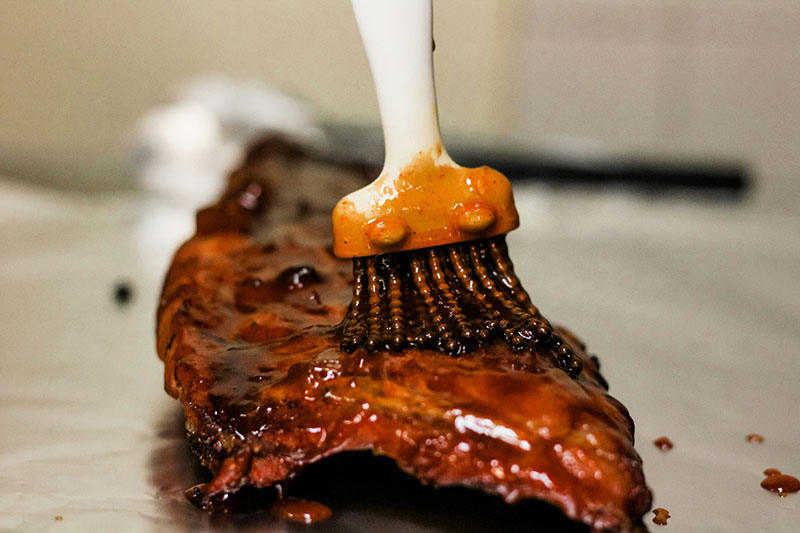Sprinkle and slather your ’cue with these handcrafted choices.
Barbecue is a quintessential American favorite, and while we can all agree that it is delicious, what we consider the defining flavor of the ideal sauce and rub may be disputed. Among the contenders are Alabama white sauce, Hawaiian barbecue (aka huli-huli sauce), and the beloved Texas-style barbecue sauce, with its sweet tang and touch of heat delivered in a thin, tomato-based consistency. The vinegar-forward Carolina barbecue sauce introduces mustard as a main ingredient.
In a quest to find the best sauce in the nation, the folks behind Smoked BBQ Source interviewed 3,000 taste testers, ultimately identifying Arizona-style sauce as the chart-topper. “[I]t’s the John Wayne of BBQ sauces, bold and smoky, with a chili pepper lasso that wrangles any wild meat into submission,” the website states. “It’s got more kick than a mule with a cactus thorn in its side.”
Chef Karen Cannan, director/professor/executive chef of Truckee Meadows Community College’s Culinary Arts program in Reno, has sat at the table as a returning judge at The Best In The West Rib Cook Off at The Nugget in Sparks. She explains that the range of flavors she’s experienced is vast, but she often looks for sauces and rubs that highlight the sweet, smoky, spicy notes evenly without any one profile taking center stage. When making barbecue sauces and rubs at home, Canaan recommends focusing on the flavors you like most and including spices with a light hand.
“Barbecue sauce is a pretty simple thing,” she says. “Tomato paste is the base, and brown sugar brings richness with molasses notes. Corn syrup or honey are two other items usually added. Other dry ingredients like garlic powder and onion powder work really well when you’re blending a sauce. Sauces and rubs are a simple premise, but, boy, they can have so many variables with the finished product.”
Canaan goes on to explain that she’s seen many people mimic the grill masters’ constant brushing of sauce, which is entertaining at the cookoff but can be catastrophic to at-home efforts.
“If you start putting barbecue sauce on too early, the sugar ends up burning,” she goes on. “Save the sauce for one of the last steps. Dry rubs are really fun because they make it easy to barbecue at home. You can get a nice dry rub on there, start the meat, and finish with the sauce so you’re not burning it.”
For a nice barbecue rub, Canaan uses a blend of dry spices, brown sugar, and additional ingredients to create the ideal grill seasoning.
“Try different things like coffee grounds or lime juice to richen the flavor and make it your own,” she suggests. “It’ll be delicious.”
Flavor Boosts
Canaan suggests that, aside from the traditional base elements, you consider tinkering with these additional ingredients for the perfect sauce and rub:
- Acidic: Citrus juices, including lime, orange, and lemon, add an acidic note that will brighten and smooth out barbecue sauce.
- Spicy: Chili powder is Canaan’s go-to for spicy food. She warns that less is more, and it’s better because it blooms twice — once when mixed with anything wet, and again when it is heated.
- Smoky: In addition to wood or wood chips used for heating, paprika and liquid smoke enhance those smoky notes. Again, a tiny bit is a good start.
Barbecue Sauce
(courtesy of chef Karen Cannan, director/professor/executive chef, TMCC Culinary Arts Program in Reno. Makes about 4 cups)
2 cups water
¾ cup light corn syrup
½ cup tomato paste
½ cup white vinegar
3 tablespoons molasses
3 tablespoons brown sugar
1 teaspoon liquid smoke
½ teaspoon salt
¼ teaspoon onion powder
¼ teaspoon ground black pepper
¼ teaspoon garlic powder
Combine all ingredients in a saucepan and mix well. Over medium-high heat, bring just to a boil. Lower heat and simmer for 1 hour, stirring occasionally.
You can alter it to suit your taste: Add more brown sugar if you like it sweeter. If you want it to be spicier, add hot sauce or cayenne pepper.
Coffee Dry Rub
(courtesy of chef Karen Cannan, director/professor/executive chef, TMCC Culinary Arts Program in Reno. Makes about ½ cup)
4 teaspoons chili powder
4 teaspoons ground coffee
2 tablespoons dark brown sugar
4 teaspoons salt
¼ teaspoon turmeric
¼ teaspoon ground coriander
¼ teaspoon cayenne pepper
½ teaspoon ground black pepper
½ teaspoon garlic powder
½ teaspoon onion powder
In a bowl, combine all the ingredients together and stir until blended. For ribs, generously rub both sides of the meat and grill to cook. If desired, finish with barbecue sauce before removing from heat.


